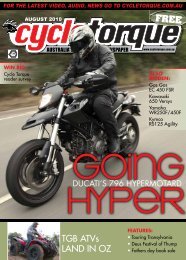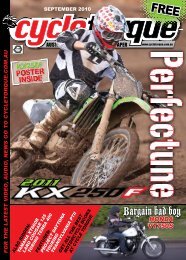CAN-AM SPYDER RT - Cycle Torque
CAN-AM SPYDER RT - Cycle Torque
CAN-AM SPYDER RT - Cycle Torque
You also want an ePaper? Increase the reach of your titles
YUMPU automatically turns print PDFs into web optimized ePapers that Google loves.
Three wheel sTarship<br />
<strong>CAN</strong>-<strong>AM</strong> has responded to the masses,<br />
introducing the Spyder <strong>RT</strong> Roadster<br />
touring model. its luggage capacity and<br />
electronic gadgetry rivals any twowheeled<br />
tourer on the market, although<br />
it’s an altogether different experience to<br />
ride.<br />
The <strong>RT</strong> Roadster is joined by the RS<br />
(Roadster Sport) which has a much<br />
sportier riding position and a lot less<br />
of the ‘fruit’ which the <strong>RT</strong> boasts. Base<br />
price of the <strong>RT</strong> is $32,190 and goes up to<br />
$41,590 for the full fruit semi-auto.<br />
<strong>Cycle</strong> <strong>Torque</strong> has sampled Can-Am’s<br />
Spyder a couple of times now but we<br />
were keen to test the new <strong>RT</strong>, because of<br />
its updates but also to see how it would<br />
stack up against bikes like the Goldwing<br />
and BMW’s K 1200 LT.<br />
Can-Am obviously knew that to appeal<br />
to customers who might normally look<br />
at the aforementioned two wheeled<br />
tourers it would have to come out with<br />
all guns blazing, offering just about every<br />
conceivable option you’ve ever seen on<br />
a bike. Many riders of the luxo-barge<br />
tourers are advanced in years and the size<br />
of such bikes can cause difficulties with<br />
low speed manoeuvring, especially twoup.<br />
One thing the Spyder offers is total<br />
feet up riding. As a result balance should<br />
never become an issue with it.<br />
in the garage<br />
The heart of the well appointed three<br />
wheeler is a 1000cc Rotax V-twin engine<br />
(Can-Am’s parent company is BRP, which<br />
incidentally owns Rotax).<br />
On tap is 100hp from the fuel-injected<br />
donk – with fly-by-wire throttle – and<br />
final drive is by belt. You can opt for<br />
the manual five-speed gearbox, or the<br />
semi-auto five-speed which is actuated<br />
by thumb and index finger. Reverse gear<br />
is easily actuated and you’ll need it if you<br />
park nose in.<br />
There’s so much under-skin framework<br />
and electronics that it could almost<br />
be a car. The size and design of the<br />
vehicle dictates the chassis, and modern<br />
technology such as the traction control<br />
and creature comforts dictate metre after<br />
metre of wiring and computers.<br />
There are so many safety and comfort<br />
features on the <strong>RT</strong> Roadster we couldn’t<br />
possibly cover them all in detail here. In<br />
an attempt to keep you as safe as possible<br />
there’s the Stability Control System which<br />
automatically alters power and braking<br />
if the <strong>RT</strong> becomes unstable; ABS brakes<br />
which need no real explanation, and<br />
traction control which changes fuel and<br />
ignition settings to reduce power when<br />
needed. The traction control settings will<br />
also accommodate your riding if you<br />
have the optional <strong>RT</strong>-622 trailer fitted,<br />
once it gets through ADR-requirements.<br />
On the comfort side of things you<br />
have the very plush leather seat, electric<br />
windshield, heated hand grips (the<br />
passenger has their own controls for the<br />
heated grips which sit either side of the<br />
pillion seat), stereo (which gets louder as<br />
your speed rises) with iPod integration<br />
and enough luggage space that if it’s not<br />
enough maybe you should be driving a<br />
minibus. Besides the obvious panniers<br />
and top box there’s a front luggage area<br />
and one just in front of the rider. All up<br />
155 litres. If you have the trailer there’s<br />
over 700 litres available.<br />
It’s a very pretty machine. Everything<br />
is contoured and the whole body design<br />
flows, and it certainly has a presence on<br />
the road.<br />
ride impression<br />
For a rider around the six foot mark<br />
or taller the riding position is a little<br />
cramped. There’s plenty of leg room<br />
but we tended to feel we were pushed a<br />
little too far forward, making you slump<br />
as you grabbed the ’bars. It’s a personal<br />
thing and totally dependent on your own<br />
physical makeup. Footpeg positioning<br />
was spot on, and pillions get footboards.<br />
Our pillion found the rear seat and<br />
backrest quite comfortable.<br />
Firing up the engine has a muffled sound coming from the<br />
space-age looking pipe, but at least you know it’s a healthy<br />
V-twin powering you along. The gauges give you all the<br />
information you need. Essentially it’s the same as a car – trip<br />
meters, fuel gauge, stereo details, outside temperature, gear<br />
indicator, time etc. If you can’t find it here then you probably<br />
won’t need it.<br />
Power steering is standard, so low speed manoeuvring is<br />
very easy. We picked up the Spyder from BRP’s headquarters in<br />
Bankstown on a Friday afternoon, so it was straight into peak<br />
hour. At first it can be an intimidating machine to ride, but so<br />
are any of the big two-wheeled tourers, especially at low speeds.<br />
It’s more about the size and steering, not anything to do with<br />
balance. This quickly goes away though as you get used to using<br />
the linked brakes (no front brake lever, the foot pedal operates<br />
them all) and the slightly quirky steering which you tend to<br />
continually overcorrect until you become accustomed to it.<br />
Power wise the engine feels a bit flat down low if you are<br />
lugging it in too high a gear, but get it revving and it accelerates<br />
quicker than you would expect something this size and weight<br />
(dry 421kg) to do.<br />
Not all electric windshields work that well but this one does.<br />
From fully down to bolt upright it was spot on, allowing you to<br />
keep your visor open the whole time. Buffeting was minimal,<br />
and the control on the left handlebar easy to reach.<br />
in the corners<br />
Of course lane splitting is a no go but after we left the traffic<br />
snarls and freeway (the cruise control was great on the freeway)<br />
we were onto a beautiful set of bends. This is where you’re most<br />
likely to experience the stability and traction control systems<br />
doing their jobs. It’s also where you’ll start to find you need<br />
to be fairly physical with the steering if you want to ride in a<br />
spirited manner. It’s very much like a quad bike to ride, you<br />
steer in the direction you want to go and lean off the inside<br />
while you’re doing it.<br />
We encountered some wet bends and the extra foot print of the<br />
three tyres made it a blast to ride, allowing you to wag the tail out<br />
just a little, all the time feeling confident in the bike’s ability to<br />
cope with the conditions.<br />
You do need to adjust your style of riding to suit the Spyder. A<br />
couple of times I came into a bend and braked firmly, causing the<br />
bike to want to run wide. I soon realised this was because of the<br />
linked brakes. So a change of tact, brake before you enter the bend<br />
and release as you are steering, just like you do in a car.<br />
The other idiosyncrasy which takes a little getting used to is<br />
the stability control. If you go through a corner fast enough to<br />
14 - APRIL 2010 Can-Am didn’t have to look far for the<br />
APRIL 2010 - 15<br />
Dash is as comprehensive as a car’s.<br />
Rotax engine. It’s in the family.





